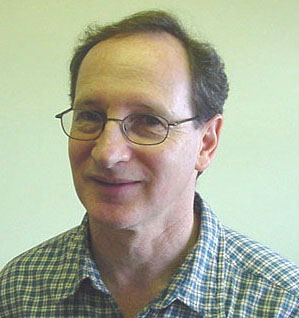|
Title:
The science of reading
Author: Ada Tam
Category: UNSW Research
Marcus Taft is a psychology professor at the University
of New South Wales whose influential research on psycholinguistics
makes him one of the pioneers in this field. For the past
thirty years, Taft has investigated the influence orthography
and morphology has on reading ability
and differences between readers in other languages such as
French, Spanish, Chinese and Japanese.

Professor Marcus Taft
|
Taft proposes
that it is the BOSS (Basic Orthographic Syllabic Structure)
that guides the process of ‘breaking up’ longer words when
reading. The BOSS is a combination of letters that form a
syllable that has an onset, vowel and
coda, such as ‘cat’ in ‘catapult’. This
syllable maximises how informative the first part of a word
is by taking the onset of the next syllable as the coda of
the first, even if it contradicts with the pronunciation.
For example, when you read the word ‘cigar’, it is mentally
processed as ‘cig-ar’ even though you pronounce it as ‘ci-gar’.
Morphemes
may also play a part in how we process words. Taft believes
that when a prefixed word such as ‘retrieve’ has been recognised,
it is split into prefix (re) and stem (trieve) components,
and the reading of the word is based on the stem only. Taft
argues that ‘trieve’ is the BOSS rather than ‘ret’, which
means that the BOSS does not necessarily have to be the first
syllable of a word.
It is
likely that the same basic system is used across different
languages. However, for languages that are more syllabic,
people are more reliant on the pronunciation of the word when
reading. When native speakers of a foreign language read English,
they read in the same way that they would for their native
tongue. Therefore, the letters are combined and grouped differently
from the best possible way for English. The clearest example
is Japanese, which is based on a consonant-vowel structure.
“Consonant-vowel
is represented by a single character in the writing system.
A word like ‘lemon’ would have ‘le’ as a unit and ‘mo’ as
another unit. For them, to put the ‘m’ with ‘le’ would be
entirely alien. And that is going to lead to problems if the
optimal way of reading English is to put the ‘m’ with the
‘le’.”
Some useful applications
Taft’s
research has the potential to improve ways of teaching children
how to read. He believes that better readers may make use
of the BOSS whereas poorer readers might rely on the spoken
syllable. Nevertheless, he expresses caution in publicising
his preliminary findings.
 In
the future, the BOSS may improve methods for teaching
children how to read. Photo: Joana
Franca
In
the future, the BOSS may improve methods for teaching
children how to read. Photo: Joana
Franca |
“If I
could get stronger evidence that can convince even me
that this is the way that poorer readers process words, and
this is the way that better readers process words, then I
would be very keen to translate that to the education setting,”
says Taft.
Some of
his research on Chinese already had some practical applications.
One of his studies has shown that linking the Chinese characters
to its individual components facilitates learning of written
Chinese. Furthermore, he has applied for a patent on improvements
to pinyin, the Chinese alphabetic system that teaches pronunciation.
Funding and plans for the future
Although
psycholinguistics is a relatively small area in psychology,
Taft has been fortunate to receive continuous funding since
joining the academic staff at UNSW in 1981. He reflects that
it may be useful to develop a reputation in a smaller area
and that “it may be easier to be a big fish in a small pond
than it is to be a small fish in a big pond.” However, Taft
is quick to point out that this has been largely due to the
influence of his PhD supervisor, Ken Forster. “Lexical processing,
word recognition, and psycholinguistics in general are proportionally
quite strong in Australia. His [Ken Forster] students and
other people have been influenced by him.”
At the
moment, Taft is in the first year of a three-year grant and
is currently trying to integrate reading, speech recognition
and spoken output. He hopes to have a few PhD students working
in psycholinguistics in the future once there is more concrete
evidence for individual differences between readers, as he
would like to push that into an applied direction.
“I am
reaching a stage of my career where one should be tying it
altogether, or looking for new areas,” says Taft. “I certainly
go through periods with my research and have done a few years
where you feel a bit jaded with the whole thing. And then,
what it needs is some exciting findings, something new that
you didn’t expect to emerge, or an idea that you have.”
Taft reveals
that in the future there may be “some major change in direction”
in his own research as he is interested in episodic memory.
A future honours student’s work may also influence him in
this regard.
“They
might come in and say they are interested in a particular
area and work towards a project,” says Taft. “That might trigger
me [to do] a new line of research if it comes out in an interesting
way.”
See OnSET's Why
do we say the things we do?
Glossary
Coda
syllable: Phonetic sound at the end of the word
Morpheme:
The smallest unit in a word that has meaning or a grammatical
function
Morphology:
Form and meaning
Onset syllable:
Phonetic sound at the beginning of the word
Orthography:
Spelling; form of the word
Psycholinguistics:
The study of the psychology of language
Further Reading
Taft,
M. (1979). Lexical access via an orthographic code: The basic
orthographic syllabic structure (BOSS). Journal of Verbal
Learning & Verbal Behavior, 18, 21–39.
Taft,
M. (2002). Orthographic processing of polysyllabic words by
native and nonnative English speakers. Brain & Language,
81, 532–544.
Taft,
M. & Chung, K. (1999). Using radicals in teaching Chinese
characters to second language learners. Psychologia,
42, 243–251.
Taft,
M., & Forster, K. I. (1975). Lexical storage and retrieval
of prefixed words. Journal of Verbal Learning & Verbal
Behavior, 14, 638–647.
|